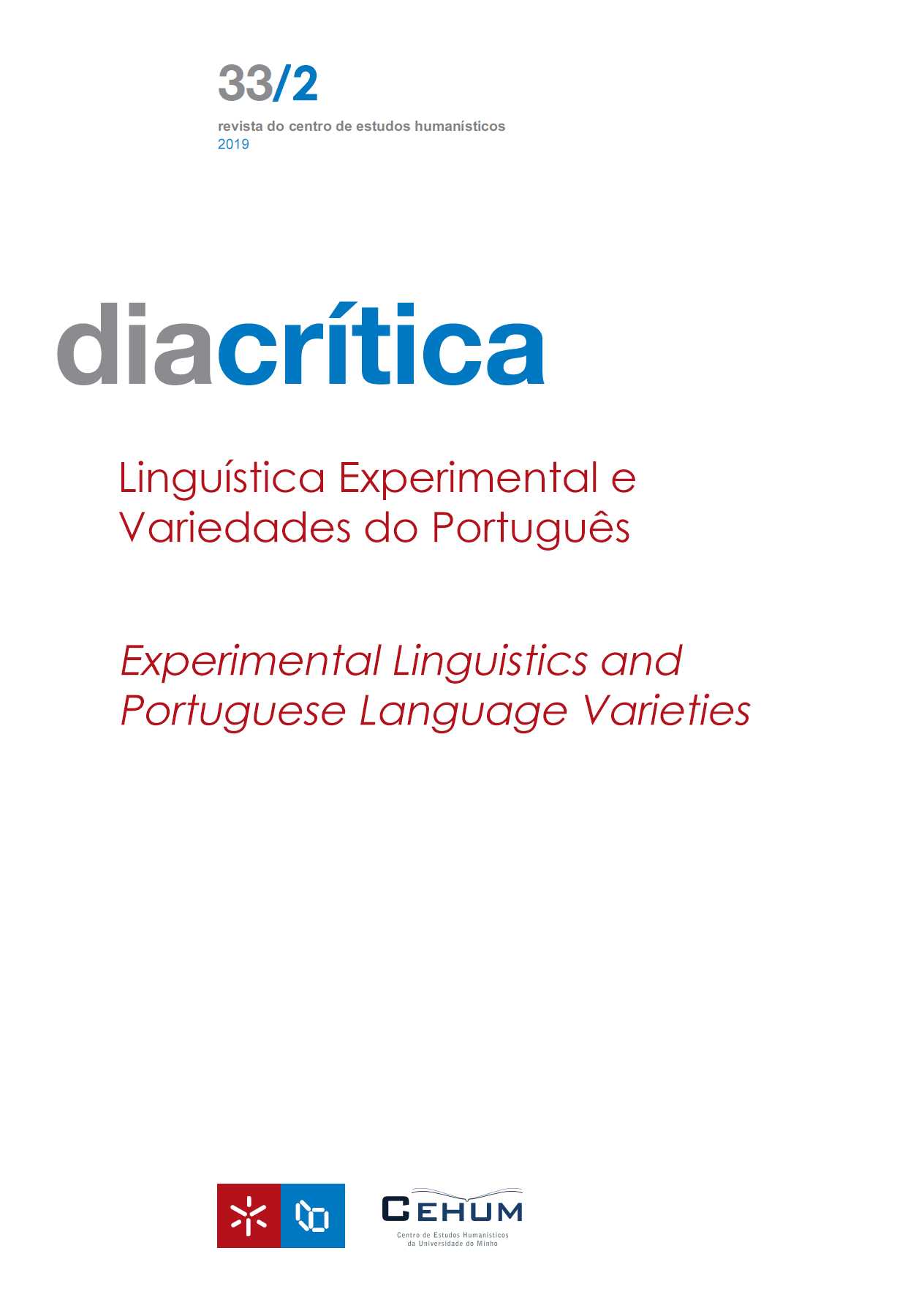The caused-action construction in brazilian portuguese (BRP) and its effects on the comprehension and production of BRP-english bilingual speakers
DOI:
https://doi.org/10.21814/diacritica.5062Keywords:
Caused-action construction, Indirect causative meaning, Bilingual evidenceAbstract
A central assumption of construction-based theories of grammar, especially Construction Grammar, is that argument structure constructions, which are clausal patterns made of ordereds equences of syntactic slots paired with semantic content, have meaning of their own. Thereby, argument structure constructions contribute meaning which is independent of the meaning of the individual lexical items that instantiate them. Based on that, in this paper we address Brazilian Portuguese (BrP) sentences like Eu cortei o cabelo (literally I cut the hair, meaning that I had my hair cut) and its effects on the BrP-English bilinguals’ production and comprehension in English. The objectives are: i) to describe the caused-action meaning associated with the transitive form in BrP; ii) to represent the caused-action construction in BrP, following the analysis started with Ciríaco (2014); and iii) to present part of the results of the study carried out by Santos (2019), showing experimental evidence from bilingualism. Finally, our paper shows that the caused-action meaning plays a role cross-linguistically, and that the caused-action construction is a type of construction, present in BrP and English as well.
References
Bencini, G. & Goldberg, E. (2000). The contribution of argument structure constructions to sentence meaning. Journal of Memory and Language, 43 (4), 640–651. https://doi.org/10.1006/jmla.2000.2757
Boas, H. C. & Gonzálvez-García, F. (2014). Applying constructional concepts to Romance languages. In H. C. Boas & F. Gonzálvez-García (Eds.), Romance perspectives on construction grammar. [Constructional approaches to language series, 15] (pp. 1–35). Amsterdam: John Benjamins. https://doi.org/10.1075/cal.15.01boa
Ciríaco, L. S. (2014). A construção transitiva de sujeito agente-beneficiário no português brasileiro. Caligrama: Revista de Estudos Românicos, 19 (2), 83–98.
https://doi.org/10.17851/2238-3824.19.2.83-98
Croft, W. (2001). Radical construction grammar: Syntactic theory in typological perspective. Oxford: Oxford University Press. https://doi.org/10.1093/acprof:oso/9780198299554.001.0001
Christensen, R. H. B. (2015). Ordinal: Regression models for ordinal data. R package version 2015, 6–28. Retrieved from https://cran.r-project.org/package=ordinal
Davies, M. (2008). The corpus of contemporary American English (COCA): 400+ million words, 1990-present. Available online at https://www.english-corpora.org/coca/
Fillmore, C., Kay, P. & O’Connor, M. (1988). Regularity and idiomaticity in grammatical constructions: The case of let alone. Language, 64 (3), 501–538.https://doi.org/10.2307/414531
Gardner-Chloros, P. (2008). Bilingual speech data: Criteria for classification. In L. Wei & M. G. Moyer (Ed.), The Blackwell guide to research methods in bilingualism and multilingualism (pp. 53–72). Malden: Blackwell Publishing.
Goldberg, A. E. (1995). Constructions: A construction grammar approach to argument structure. Chicago, IL: University of Chicago Press.
Goldberg, A. E. (2003). Constructions: a new theoretical approach to language. Trends in Cognitive Sciences, 7 (5), 219–224. https://doi.org/10.1016/S1364-6613(03)00080-9
Goldberg, A. E. (2006). Constructions at work: the nature of generalization in language. Oxford: Oxford University Press. https://doi.org/10.1093/acprof:oso/9780199268511.001.0001
Grosjean, F. (2008). Studying bilinguals. Oxford: Oxford University Press.
Johnson, M. A. & Goldberg, A. E. (2013). Evidence for automatic accessing of constructional meaning: Jabberwocky sentences prime associated verbs. Language and Cognitive Processes, 28 (10), 1439–1452. https://doi.org/10.1080/01690965.2012.717632
Langacker, R. & Langacker, R. W. (2008). Cognitive grammar: A basic introduction. Oxford: Oxford University Press. https://doi.org/10.1093/acprof:oso/9780195331967.001.0001
Michaelis, L. (2012). Making the case for construction grammar. In H. C. Boas & I. A. Sag (Eds.), Sign-based construction grammar (pp. 31–69). Stanford, CA: CSLI Publications.
Nation, I. S. P. (1990). Teaching and learning vocabulary. New York: Heinle ELT.
Santos, C. F. (2019). Processing of the English causative-have construction by monolinguals and Brazilian Portuguese-English bilinguals (Master’s thesis, Universidade Federal de Minas Gerais, Belo Horizonte, Brazil). Retrieved from http://hdl.handle.net/1843/LETRBAPPSX
Wasserscheidt, P. (2014). Constructions do not cross languages: On cross-linguistic generalizations of constructions. Constructions and frames, 6 (2), 305–337.
Downloads
Published
How to Cite
Issue
Section
License
Copyright (c) 2023 Clarice Fernandes dos Santos, Larissa Santos Ciríaco, Ricardo Augusto Souza

This work is licensed under a Creative Commons Attribution-NonCommercial 4.0 International License.










